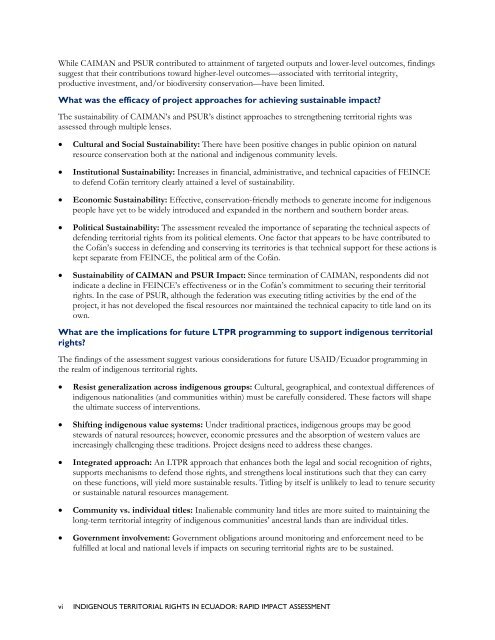ECUADOR - Land Tenure and Property Rights Portal
ECUADOR - Land Tenure and Property Rights Portal
ECUADOR - Land Tenure and Property Rights Portal
- No tags were found...
Create successful ePaper yourself
Turn your PDF publications into a flip-book with our unique Google optimized e-Paper software.
While CAIMAN <strong>and</strong> PSUR contributed to attainment of targeted outputs <strong>and</strong> lower-level outcomes, findingssuggest that their contributions toward higher-level outcomes—associated with territorial integrity,productive investment, <strong>and</strong>/or biodiversity conservation—have been limited.What was the efficacy of project approaches for achieving sustainable impact?The sustainability of CAIMAN’s <strong>and</strong> PSUR’s distinct approaches to strengthening territorial rights wasassessed through multiple lenses.• Cultural <strong>and</strong> Social Sustainability: There have been positive changes in public opinion on naturalresource conservation both at the national <strong>and</strong> indigenous community levels.• Institutional Sustainability: Increases in financial, administrative, <strong>and</strong> technical capacities of FEINCEto defend Cofán territory clearly attained a level of sustainability.• Economic Sustainability: Effective, conservation-friendly methods to generate income for indigenouspeople have yet to be widely introduced <strong>and</strong> exp<strong>and</strong>ed in the northern <strong>and</strong> southern border areas.• Political Sustainability: The assessment revealed the importance of separating the technical aspects ofdefending territorial rights from its political elements. One factor that appears to be have contributed tothe Cofán’s success in defending <strong>and</strong> conserving its territories is that technical support for these actions iskept separate from FEINCE, the political arm of the Cofán.• Sustainability of CAIMAN <strong>and</strong> PSUR Impact: Since termination of CAIMAN, respondents did notindicate a decline in FEINCE’s effectiveness or in the Cofán’s commitment to securing their territorialrights. In the case of PSUR, although the federation was executing titling activities by the end of theproject, it has not developed the fiscal resources nor maintained the technical capacity to title l<strong>and</strong> on itsown.What are the implications for future LTPR programming to support indigenous territorialrights?The findings of the assessment suggest various considerations for future USAID/Ecuador programming inthe realm of indigenous territorial rights.• Resist generalization across indigenous groups: Cultural, geographical, <strong>and</strong> contextual differences ofindigenous nationalities (<strong>and</strong> communities within) must be carefully considered. These factors will shapethe ultimate success of interventions.• Shifting indigenous value systems: Under traditional practices, indigenous groups may be goodstewards of natural resources; however, economic pressures <strong>and</strong> the absorption of western values areincreasingly challenging these traditions. Project designs need to address these changes.• Integrated approach: An LTPR approach that enhances both the legal <strong>and</strong> social recognition of rights,supports mechanisms to defend those rights, <strong>and</strong> strengthens local institutions such that they can carryon these functions, will yield more sustainable results. Titling by itself is unlikely to lead to tenure securityor sustainable natural resources management.• Community vs. individual titles: Inalienable community l<strong>and</strong> titles are more suited to maintaining thelong-term territorial integrity of indigenous communities’ ancestral l<strong>and</strong>s than are individual titles.• Government involvement: Government obligations around monitoring <strong>and</strong> enforcement need to befulfilled at local <strong>and</strong> national levels if impacts on securing territorial rights are to be sustained.viINDIGENOUS TERRITORIAL RIGHTS IN <strong>ECUADOR</strong>: RAPID IMPACT ASSESSMENT
















